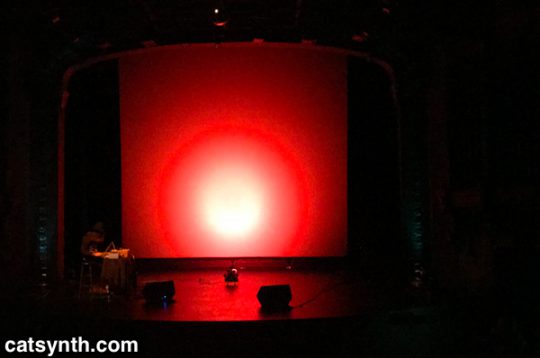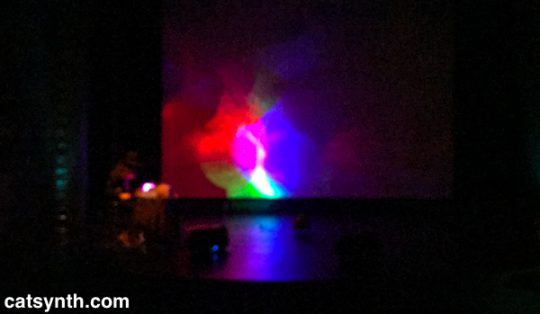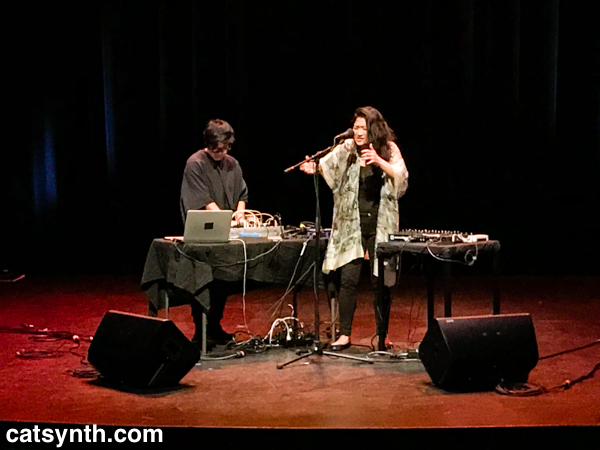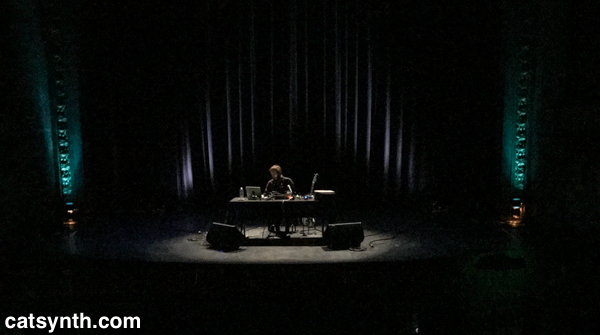Today we look back at a concert of works by Polly Moller at Trinity Chapel in Berkeley, CA that I attended back in December. This concert was a large undertaking, not only with a full night of music by a single composer, but a large cast of characters from the Bay Area new-music scene, as one might see at an event like the Skronkathon, but in this case all working towards a single purpose and vision. There were several pieces I was already familiar with from previous performances, including two that I have performed myself. Three others were being premiered. Mythology and narrative seemed to permeate all of the pieces, whether drawn from specific mythological stories or unfolding through rituals and rule-based processes.
(As with several of the larger performances and events I attended last year, I was live tweeting @catsynth, and have included a few choice tweets in this larger review.)
The concert opened with a performance of The Flip Quartet. I had first seen it performed at Hypnogogia at the Climate Theater in 2009, and then had the opportunity to participate in a performance myself later the same year. This performance brought back the original lineup of Karl Evangelista, Jason Hoopes, Thomas Scandura and Bill Wolter. Four stations were set up, representing the four cardinal directions and the traditional elements of air, water, fire and earth. At each station was an array of instruments and other objects that in some way represented that element (e.g., wind instruments at the air station, electrical instruments at the fire station, etc.). Each performer starts at a station and improvises using the objects for two minutes before advancing to the next and repeating the process. Musically, this can really go in many any number of directions (no pun intended) based on the particular objects available and the sensibilities of the performers involved. Often the sounds happen coincidentally, but every so often the four performers come together and produce that is musically integrated (@catsynth Lots of nice gurgling and drumming and whistling. Strong musical moment.) This was the first time I had seen the piece performed on a traditional proscenium. The previous performances were done in the round with the audience in the center and the stations surrounding them. While it was easier to see all the performers at once this way, there was something fun about the round format, the connection to the elemental and directional aspects and the ability to see the instruments close up.
Next was the premier of Duo No. 1 featuring Gino Robair on a variety of instruments and Krystyna Bobrowski playing a “sliding speaker instrument.” The piece has a dual identity as a narrative following the life cycle of a moth and an excuse to make Gino Robair “play really, really quietly.” And indeed, it was relatively quiet and subtle, but still with a lot of dynamic energy. Robair played a variety of percussion instruments, including the signature broken cymbal that I often see him play. Robair’s sounds are fed into the speaker in Bobrowski’s instrument and excite the tube, which she can then vary in length to change the timbre of the sound.

Bobrowski was able to get quite a variety of interesting timbres from her “acoustic signal processor”, which then informed how the improvisational duet unfolded within the context of the overall graphical score.
The next piece, Penelope, was perhaps the most traditional of the evening, as it was through composed for a single performer on piccolo with supporting vocal and foot-stomping parts. It was commissioned for and performed by Amy Likar.

The piece based on the final chapter of James Joyce’s Ulysses (which is of course itself inspired by Greek mythology), and the extended piccolo techniques, combined with the irregular foot-stomp rhythms and repeated breathy voicing of the word “yes” are intended to “evoke Molly Bloom’s sensual stream of consciousness.” I found myself mostly focused on the combination of the foot stomps, trying to find syncopated patterns whether or not they were there, and the surprisingly powerful sounds from the extended instrumental techniques. (@catsynth Who knew the piccolo could be such an angry instrument?)
After a brief intermission, the concert resumed with a performance of the Three of Swords. I had first seen Polly perform this piece for Pamela Z’s ROOM series at the Royce Gallery in San Francisco. This version was performed by Sara Elena Palmer using vocals and electronics.

The narrative structure is a bit more abstract in this piece, but it is nonetheless present through the highly ritualized nature. The program notes describe it as a “sound-art divination ritual for solo performer and tarot cards.” It unfolds with the setting of a 20-minute hourglass and lighting a series of candles. For each candle, the performer draws a card from the tarot deck arrayed out in front of her, and interprets the card musically. (@catsynth http://yfrog.com/hsv2tzj pick a card any card.) At the end of each section, the corresponding candle is extinguished. Sara Elena Palmer’s bright red costume and head covering (which she removed during the recitation concerning the heart) seemed to be an integral part of her interpretation of the ritual. Among the more interesting musical elements she employed was a radio used to generate analog noise sounds.

The next piece, Alcyone is based on the Greek legend of Alcyone, the Kingfisher Queen, who calms the ocean for seven days before and after the winter solstice so she can incubate her eggs in a nest on the waves. (Appropriately, this concert took place three days before the winter solstice.) Musically, the piece opens with an energetic instrumental quartet featuring Philip Greenlief on clarinet, Cory Wright on bass clarinet, Lisa Mezzacappa on contrabass and Suki O’Kane on percussion. After a stretch of time, mezzo-soprano Laura Malouf-Renning entered the stage regally costumed with a black cape and crown and carrying a nest with Christmas ornaments (@catsynth A festive birds nest). She silenced the instrumentalists one by one with a tap on the shoulder, and began an expressive monologue.
The final piece of the evening was Genesis for 12 performers. I had first seen this piece at its premier at the Quickening Moon Concert last year, and then had the opportunity to perform it myself with Cardew Choir last summer. This version followed closely the personnel and interpretation of the original performance, featuring Polly as the conductor and Matt Davignon in the role of the new universe. The piece combines “Western magical tradition” with the concept of the 11-dimensional universe from string theory. The performers represent each of the dimensions, with special roles for the conductor, the timekeeper who represents the time axis, and three performers representing the conventional spatial dimensions. The final performer represents the new universe that is born from the multi-dimensional processes.

The performers are arranged in a very specific spiral formation with the new universe (Davignon) at the center. The conductor (Moller) carries chimes and walks the spiral, tapping each performer to enter or exit. The sound starts out slowly and gradually, but then builds into a loud crescendo as the new universe is born. At this point, Davignon took over with a solo on live electronics. Like many of his other electronic performances, he achieves a very organic sound with lots of textural details, sometimes liquidy or like a series of objects being shaken or dropped. After the new universe solo, the spiral reverses as the other dimensions re-enter, but gradually get softer before a final statement by the new universe.
(@catsynth #pollymoller concert concludes. Good night!)










